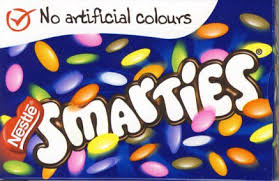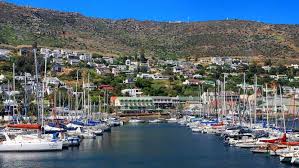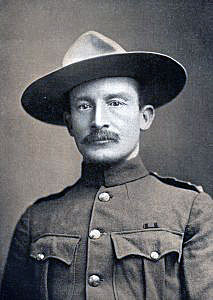
You can buy me expensive chocolates and I will enjoy them but my favourites are Smarties! For those who are not South African these little chocolate pebbles are covered by different coloured crisp sugar that you can suck until the chocolate oozes out or bite sharply into them. A packet of them goes down well in the middle of the night. I had bought them to make Smartie biscuits but somehow they found themselves on my bedside table!
So I chewed and pondered on many things. Especially childhood memories of Fish Hoek. Along the beach there is a catwalk set into the rocks. The rock pools were a delight of bright sea urchins, pebbles and small klippie fish that darted in and out of little caves. One larger pool was called Skellie, I don’t know why, and we would dive off the rocks into the deep pool.
P.W. Botha became Prime Minister of South Africa and Apartheid had the effect of making South Africa a pariah in the international community of nations. P.W, as he was called, needed money and allowed the Chinese long liners into False Bay. They were after great white sharks for shark fin soup. Suddenly the whole eco system of the bay was affected and the rock pools were emptied of their occupants.
This got me thinking of the diminishing lion populations of Africa. If these great predators are endangered the whole ecosystem of the great parks will be in danger. Susan and I were in Etosha pan, worrying about being late for the gate of Namutoni when we saw this pale lioness in attacking position, her tail stretched straight and her gaze fixed upon a hidden prey. We held our breath as she stood immobile, the fading light giving a luminescence to her coat. Time stood still until we unfortunately had to depart but the picture has remained clear in my mind and whenever I am in great pain the picture comes into focus yet again, comforting me.
As a girl I loved the train journey to and from Fish Hoek to Cape Town. The rail runs along the sea from Simonstown to Muizenberg with a great view of False Bay. Along this section the train stops at St. James, Kalk Bay and Clovelly. We would go to the bioscope at Muizenberg on Saturday and on the journey back would alight at Clovelly and walk to Fish Hoek along the beach.
These days the road winds between the little towns with the crags of Table Mountain chain rearing on the right hand, the breakers bashing themselves on the rocks on the other side. When my first grandsons were small I took them fishing with little nets for klippies at St. James and we caught two each, watching them swim around the bucket. The time came to return them to their pools and the two boys burst into tears, wailing at the loss of their fishy friends.
When we moved to Fish Hoek my father built our house himself. The lounge/diningroom was on a wonderful sprung floor and the local Old Time Dance club came every Friday evening. One of the members brought his young son, Donald, five years older than me but the two of us learnt to dance these gracious dances. I was around 16 I think, Donald would take me walking on the Fish Hoek mountains singing The Road to the Isles in his lovely baritone. He finally left Fish Hoek to take up a career in banking in Rhodesia as it then was, now Zimbabwe. That was the last time I saw him, but we have corresponded ever since. He now lives in Sydney, Australia with his wife Jan. Donald is also a writer, mostly of poems and over the years has sent me many an amusing naughty poem!
I learnt to waltz at those dances and loved to dance with my father who took long steps when we danced to The Blue Danube! None of my boyfriends could match that! However, one of them could jive and when we took to the floor at Royal Cape Yacht Club, the other dances would retire while we performed!

These days the road from Muizenberg to Fish Hoek has become very trendy. Kalk Bay has a restaurant called The Brass Bell on the station where the waves crash against a huge picture window. Further along is the little harbour with a breakwater that keeps the huge waves at bay. My father used to fish off this pier and I was always terrified that a wave would sweep him into the sea. There are trendy restaurants in the harbour now and you can buy fresh snoek straight off the boats. The snoek is a relative of the barracuda, long and silvery with pointed teeth. This fish is delicious on the braai or barbecue, brushed with apricot jam.

The railway ends at Simonstown which was a British Naval Base when I was a girl. A Great Dane called Nuisance used to catch the train to Cape Town where he would round up all the sailors who were a little worse for wear, see them onto the train and escort them back to base at Simonstown. There is a statue to him in the town and also a good book about his exploits.

The South African Navy runs the base now and when a boyfriend and I were stranded on his yacht moored in the little harbour, the dinghy having broken loose in the brisk southeaster wind, I radioed the Navy for help. They very kindly sent a boat to take us ashore.
I was awarded my Queen’s Guide badge by Lady Joy Packer at Admiralty house in Simonstown. Lady Packer wrote a book called Grey Mistress about her husband’s destroyer that she followed to ports around the world where her husband Sir Herbert was based. She loved South Africa and wrote a novel called Valley of the Vines a love story set in Constantia in Cape Town.
Lady Olave Baden-Powell came to Cape Town and a pageant was performed in her honour. Fish Hoek Guides were dressed in ancient Greek robes to represent the Dhodhekanisos Islands in Greece in the pageant wearing ancient Greek robes that were in reality sheets! Our venue was a stone amphitheatre just below Table Mountain and the perfect site. I was thrilled to be included and Lady Olave shook all our hands.
Lady Olave’s husband was of course Lord Robert Baden-Powell of Gilwell and the man in charge of the siege of Mafeking. Mafeking as it used to be called is a town on the north west border of South Africa with Botswana. During the Boer war the British wanted to divert Boer troops from the conflict in Natal and a small garrison was to be set up at Mafikeng under the command of Colonel Robert Baden-Powell.

The Boer General Cronje was sent to attempt to occupy the town and defeat the garrison. The Boers underestimated Baden-Powell’s resourcefulness. He manufactured structures that looked like railways and guns and then proceeded to make a canon out of scrap that was called The Wolf. This canon was used to fire bits of scrap at the Boers. He also found an old muzzle loader holding up a gate post that they used to fire at the Boers, naming it Lord Nelson. He made grenades from dynamite and eventually even constructed a small railway across the town. All in all he managed to convince the Boers that the garrison was a greater force than they had thought. Here it was that Baden Powell conceived the idea of a Boy Scout movement using children to carry messages and assist in hospitals.
When he and Lady Olave married she started the Girl Guide movement. I was a patrol leader in the Fish Hoek Guides and used to take my patrol hiking up the mountains that surrounded the village. We often camped overnight. I think that time in my life led to my love of adventure and curiosity to experience the bush.
